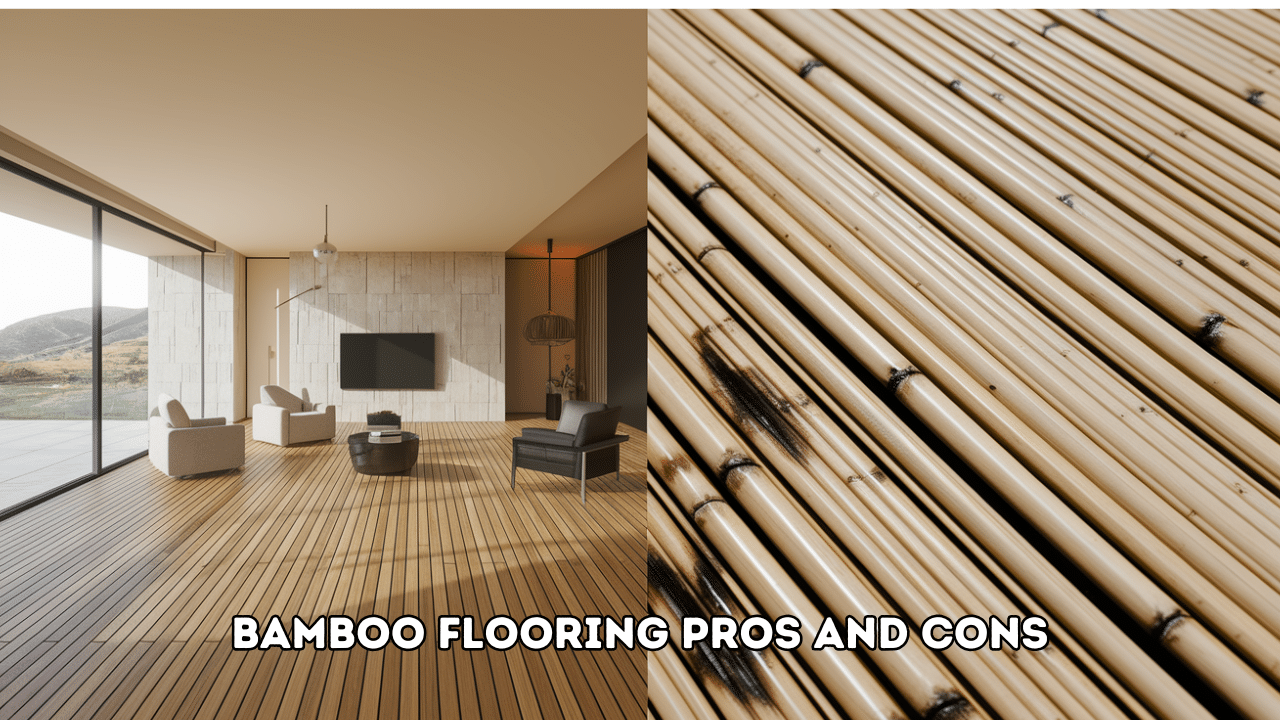Bamboo flooring stands at the crossroads of sustainability and style, but its performance hinges on something many homeowners overlook: climate.
While this eco-friendly option attracts attention for its hardness and renewable nature, the reality is that your local weather patterns will ultimately determine its success in your home.
Temperature swings, humidity levels, and seasonal changes can either showcase bamboo’s strengths or expose its vulnerabilities.
Before committing to this increasingly popular flooring choice, understanding how your specific climate affects bamboo could save you from costly disappointments and help you implement the right preventative measures for lasting beauty.
What is Bamboo Flooring?
Bamboo flooring is a type of flooring made from bamboo, specifically from species like Moso bamboo.
Unlike traditional hardwood from trees, bamboo is technically a grass that matures in just 5-7 years.
The material consists of bamboo strips or fibers that are processed, treated, and bonded together to create durable planks suitable for residential and commercial flooring.
Types of Bamboo Flooring

Understanding the different types of bamboo flooring can help you choose the best option for your specific needs and preferences.
Horizontal Bamboo
Horizontal bamboo offers a distinctive, traditional look that showcases bamboo’s natural characteristics.
- Bamboo strips laid flat and pressed together horizontally
- Shows distinctive nodes and growth patterns of bamboo
- Typically softer than other types (Janka hardness rating around 1,300-1,600)
- Natural, traditional bamboo appearance
Vertical Bamboo
Vertical bamboo provides a more uniform appearance with enhanced stability properties.
- Strips positioned on their narrow edges and fused vertically
- Creates a more uniform, linear appearance with less visible nodes
- Similar hardness to horizontal (Janka hardness rating around 1,300-1,600)
- Slightly more stable in humidity changes than horizontal
Strand-Woven Bamboo
Strand-woven bamboo stands out as the most durable option, offering exceptional hardness and versatility.
- Made by shredding bamboo fibers, mixing with adhesives, and compressing under extreme pressure
- Significantly harder than traditional types (Janka hardness rating of 3,000+)
- More random, wood-like grain pattern
- Most durable bamboo flooring option, comparable to the hardest exotic hardwoods
- Available in a wider range of colors and textures
Engineered Bamboo
Engineered bamboo combines the beauty of bamboo with enhanced stability and installation flexibility.
- Consists of a thin layer of bamboo veneer over a plywood or HDF core
- More stable in varying humidity environments
- Easier installation with click-lock systems
- Lower overall profile (thinner than solid bamboo)
- Generally less expensive than solid bamboo options
- Compatible with radiant heating systems
Each type offers different aesthetic qualities, durability levels, and price points, making bamboo flooring versatile for various home applications and design preferences.
Pros of Bamboo Flooring

Considering bamboo for your next flooring project? Here’s why it might be an excellent choice for your home or business.
1. Environmental Benefits
Bamboo is one of the fastest-growing plants on Earth, reaching maturity in just 5-7 years compared to hardwoods’ 20-120 years. This rapid regeneration makes it a highly renewable flooring resource.
Bamboo cultivation causes minimal ecosystem disruption as the root systems remain intact after harvesting. These plantations typically require fewer pesticides and fertilizers than commercial tree farms.
Bamboo plants are exceptional carbon sequesters, absorbing up to 35% more carbon dioxide than equivalent tree stands while releasing 35% more oxygen into the atmosphere.
2. Durability and Performance
Strand-woven bamboo achieves impressive Janka hardness ratings of 3,000-5,000, outperforming most domestic hardwoods like oak (1,290) and maple (1,450).
High-quality bamboo floors resist scratches and dents exceptionally well, particularly strand-woven varieties.
Quality bamboo flooring demonstrates excellent dimensional stability, expanding and contracting less than hardwood when exposed to humidity fluctuations.
With proper maintenance, bamboo flooring typically lasts 20-25 years in residential settings, comparable to many traditional hardwoods.
3. Aesthetic Appeal
Bamboo flooring comes in natural light blonde shades, carbonized amber tones, and various stained colors from whitewashed to dark espresso.
The distinctive grain patterns vary by manufacturing type – horizontal and vertical bamboo display characteristic nodes, while strand-woven creates unique patterns resembling exotic hardwoods.
Bamboo integrates seamlessly with diverse design styles and pairs well with various color palettes while visually expanding smaller spaces due to its light, reflective qualities.
4. Practical Advantages
Beyond aesthetics and environmental benefits, bamboo flooring offers several practical advantages that make it appealing to homeowners.
- Mid-range bamboo flooring typically costs $3-7 per square foot versus $5-15 for comparable hardwoods.
- Features user-friendly click-lock or tongue-and-groove systems for easier DIY installation.
- Cuts easily with standard woodworking tools, reducing specialized equipment needs.
- Conducts heat efficiently, distributing warmth evenly throughout spaces.
- Requires only regular sweeping and occasional damp mopping with mild cleaners.
- Doesn’t need waxing or special treatments that many hardwoods require
Cons of Bamboo Flooring

While bamboo flooring has its strong points, it’s equally important to understand the challenges it brings.
Let’s break down the key drawbacks so you can make an informed decision.
1. Durability Concerns
While bamboo is considered a hard surface, its durability can be inconsistent.
One major issue is its susceptibility to water damage—bamboo tends to warp, swell, or develop mold in areas with high moisture. Homes with pets may also experience scratching, especially with strand-woven bamboo that hasn’t been properly sealed.
Denting is another concern, particularly when heavy furniture is dragged across it or dropped items hit the surface.
2. Environmental Considerations
Though bamboo is a fast-growing plant, not all harvesting practices are environmentally responsible.
Some suppliers cut bamboo too early, which affects product durability and renewability. In addition, bamboo is often shipped from overseas, leading to a high transportation carbon footprint.
Unfortunately, the bamboo flooring industry lacks universal certification standards, making it hard for buyers to verify eco-friendly claims.
3. Installation and Maintenance Issues
Installing bamboo flooring isn’t always straightforward. Its sensitivity to humidity requires acclimation before installation to prevent gapping or buckling.
There are also special installation considerations, such as using the correct subfloor and adhesive for stability.
Additionally, cleaning bamboo floors can be tricky: too much moisture or harsh chemicals can easily damage the surface, requiring extra care in maintenance routines.
Other Drawbacks
Beyond the major issues, there are a few more subtle downsides that could impact your flooring choice, depending on your needs and lifestyle.
-
Limited color and style options: Bamboo flooring generally doesn’t offer the same variety in color, grain, or finish as hardwood or luxury vinyl.
-
Hollow sound: If bamboo floors are not installed with quality underlayment, they can produce a hollow or echoing sound when walked on.
-
Sun fading: Constant exposure to direct sunlight can cause bamboo flooring to fade or discolor over time.
-
Availability: In some regions, bamboo flooring might be harder to find or require longer shipping times and higher costs.
Bamboo Flooring Performance in Different Climates

Bamboo flooring performs differently depending on the climate conditions where it’s installed.
In high-humidity environments like tropical regions, bamboo can absorb excess moisture from the air, leading to expansion, cupping, and potential warping over time. For these areas, engineered bamboo provides better dimensional stability than solid options.
Dry climate zones present the opposite challenge. Extended exposure to extremely dry conditions can make bamboo brittle and prone to cracking. Homeowners in these regions might need to use humidifiers during dry seasons.
Coastal environments combine high humidity with salt exposure, creating particularly challenging conditions. Salt air can accelerate wear on finishes and affect adhesives.
Moderate climates with stable humidity between 40-60% provide ideal conditions for bamboo flooring, with fewer moisture-related problems and better dimensional stability.
Conclusion
The climate where you live isn’t just about what coat to wear—it’s a deciding factor in how well your bamboo flooring investment will hold up over time.
With the right preparation and selection, bamboo can thrive even in challenging environments.
To maximize performance, choose engineered options for humidity problems, implement proper acclimation periods, and maintain consistent indoor conditions.
Your attention to these climate-specific details will determine whether your floors remain stunning for decades or develop problems within years.
Have you installed bamboo flooring in an extreme climate?
Share your experience in the comments—what challenges did you face, and what solutions worked best for you?


